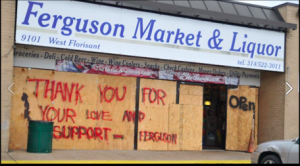FAM:
This year starts the third year of Real Talk: Hip Hop Ed for Social Justice. Our first session was quite somber as the class focused on the killing of Mike Brown, Ferguson, MO, and the history of police brutality toward Black bodies in the U.S. I had just returned from a trip to Ferguson with an amazing group of folks from the organization Black Lives Matter. That weekend over 200 people boldly drove to Ferguson to show solidarity and to practice the act of self-determination in the midst of racial injustice and violence toward Black and Brown bodies.
For our first class, I began by telling my students how much I missed and loved them. After that, I shared with them what it was like to be in Ferguson. I did not have to do a review of the events with my students before discussing my trip because their amazing teachers not only informed the students about the killing of Mike Brown, but had taken many of the students in 7th grade to a community rally in Atlanta calling for justice. Two of my students spoke at the rally as well. Below is a picture that highlights some of the student work aimed at helping students not only learn about the events that took place in Ferguson, but also creating spaces of healing for students to express their fears and frustrations.
When I told a few of my students that I was going to Ferguson, they were immediately concerned for my safety. It was heartbreaking to hear these students say such things like, “Dr. Love, don’t get shot,” or “Dr. Love, you sure you want to go there?” Upon my return, these students were eager to hear about my experiences. As our class discussion progressed, it became clear that many of the students had severe misunderstandings regarding the residents of Ferguson because of the media. Students asked me if people were mean or if I witnessed any robberies. I was happy not only to undo their misconceptions, but also to speak about the wonderful people I met in Ferguson that wanted nothing but peace and justice for Mike Brown.
After opening with my experiences, I showed students a PowerPoint I created with pictures from my trip. We discussed key people like Darnell L. Moore and Patrisse Cullors – primary organizer of Black Lives Matter – and locations in Ferguson that were distorted by the media, like the infamous convenience store from which Mike Brown supposedly stole cigars. My presentation included pictures from inside the store and the store’s sign that reads, “Thank you for your love and support – Ferguson.”
Next, we discussed the similarities and differences between the Civil Rights Movement of the 1960s and today’s more inclusive Human Rights Movement. We compared pictures of police dogs attacking Blacks 50 years ago, and similar pictures from Ferguson, as well as pictures from the 1968 nonviolent protest when sanitation workers marching in Memphis were maced and tear-gassed, and discussed how these pictures resemble Ferguson. However, unlike 50 years ago, today’s movement is spurred on by the concept that all individuals can be a part of the movement. The organizers of Black Lives Matter stressed this belief in particular while I was in Ferguson. For example, I showed them a picture of a man in a wheel chair participating at the Ferguson rally. We also discussed how queer and transgender folks not only showed up to the rally, but were at the forefront of the movement – planning, speaking, and organizing. Furthermore, we discussed how people from all religions, ethnicities, and genders are leading the push for human rights.
That conversation was a great introduction to the focus of this year’s class: deconstructing and recreating Phillip Agnew’s speech “Two Minutes.” We watched the speech once for initial reactions. My students were blown away by Agnew’s cadence and ability to pack so much information into such a short speech. One student said, “He knows everything.” Next, we listened to his speech again line-by-line, and took notes on the issues he raised, a picture of which is below. I stopped the video after each issue, so students could take a moment to discuss each topic. In one particularly poignant moment, a student asked, “Why would people close schools to create jails?” Agnew’s speech left students overwhelmed, but curious about the world they will encounter and wish to change. I informed them that each student would be researching a topic from Agnew’s speech and writing their own two-minute speech based on that issue.
Next week, we will use our class notes to research Agnew’s speech using the websites Colorlines and Black Youth Project. Lastly, students will prepare 1-2 questions each for Agnew, as he has agreed to visit Real Talk students during his trip to Atlanta.
Topics from Phillip Agnew’s Speech
1. Closing of schools to make way for state of the art prisons
2. Crime in Chicago
3. Homeless Vets
4. North Carolina & Florida – voter suppression
5. Immigrants being detained in detention camps (privately owned)
6. Trans and queer people being oppressed
7. Unfair pay and treatment of women
8. Mental Health (lack of government funding)
9. Everyone is included in today’s civil/human rights movement






I wish I had a standing ovation emoji! This is such an incredible lesson! God Bless you Bettina Love! My name is Dr. Adrian Clifton. I am a postdoc fellow at Univ. of Missouri-Columbia. I witnessed your brilliance at LRA a few years ago and have been following you every since! I am teaching my preservice teachers how to be transformative intellectuals (Giroux, 2011) and your website never lets me down! Thank you for your relevance!